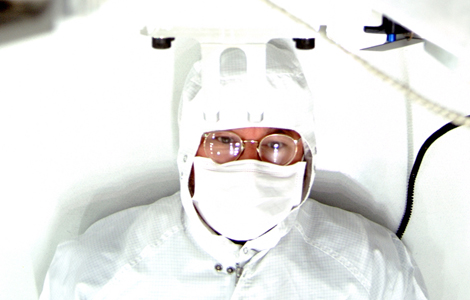A Tale of Two Mars Cameras
Director James Cameron’s 3D camera may have been bumped from the Curiosity Mars lander. But MARDI will give us first-time color views of the descent

MARDI's creator, Mike Malin, had to lie on the floor underneath the Mars rover so the camera could take this picture.
You have to give it to Mike Malin. He tried.
A couple of years ago, the planetary scientist who’s arguably the world’s foremost expert on Martian photography tried to convince NASA to include 3D video capability on the Curiosity lander that’s scheduled to touch down on Mars just after 1:30 am Eastern Monday morning. The 3D version of Malin’s Mastcam camera, as proposed by Avatar and Titanic director James Cameron, would have given us a “you-are-there” feeling of riding along with the rover as it trekked around the planet.
For defensible reasons, NASA decided not to include it.
But another Malin-built camera called MARDI — which, amazingly, was also initially axed by NASA cost-cutters — survived (barely — Malin had to put in his own money), and will film the rover’s descent as it drops to the Martian surface. Here’s NASA’s description of how it will work:
During the final few minutes of Curiosity’s flight to the surface of Mars, the Mars Descent Imager, or MARDI, will record a full-color video of the ground below. This will provide the Mars Science Laboratory team with information about the landing site and its surroundings, to aid interpretation of the rover’s ground-level views and planning of initial drives. Hundreds of the images taken by the camera will show features smaller than what can be discerned in images taken from orbit. The video will also give fans worldwide an unprecedented sense of riding a spacecraft to a landing on Mars.
MARDI will record the video on its own 8-gigabyte flash memory at about four frames per second and close to 1,600 by 1,200 pixels per frame. Thumbnails and a few samples of full-resolution frames will be transmitted to Earth in the first few days after landing….The full video — available first from the thumbnails in YouTube-like resolution and later in full detail — will begin with a glimpse of the heat shield falling away from beneath the rover. The first views of the ground will cover an area several kilometers (a few miles) across. Successive frames taken as the vehicle descends will close in and cover successively smaller areas. The video will likely nod up and down to fairly large angles owing to parachute-induced oscillations.
Many of the images may also be blurry, due to the motion of the camera. But hey, it’s video of a Mars landing, people!
I totally get that NASA has to draw the line somewhere at what to pack for its Mars expeditions, and Curiosity‘s managers struggled mightily even to stay within a bloated budget of $2.5 billion. But watch this video of the Huygens spacecraft descending to Titan’s surface in 2005, and tell me you don’t want to see the same thing (or hopefully better) on Mars.
August 6 update: Here’s a lo-res, incomplete version of the MARDI descent video. A much better version will eventually be released.